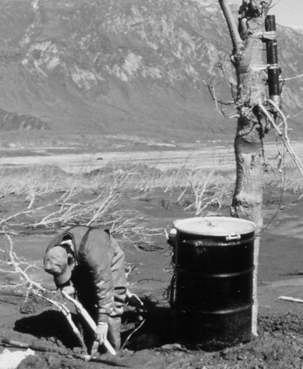Lahar Detection System
Lahar Detection System
|
It's not a matter of if one of these catastrophic flows is going to occur, it's only a matter of when. One could occur any year, any time. - Kevin Scott, USGS in World's Deadliest Volcanoes. |
Before Mount Rainier erupts, there are quite a few indicators that will allow scientists enough time to determine the problem and hopefully evacuate the towns in danger. However, as we have learned from the previous exercise, one of the biggest dangers is an unpredictable lahar. If people are informed of lahar activity in enough time, it is possible to escape physical harm by climbing or driving to higher ground. Lahars caused from an eruption can be predicted, but since lahars can also occur without warning, the challenge lies in knowing when to expect one.
Geologists estimate the travel time for large-scale lahars to reach the valley bottom, and the towns contained within, is less than one hour. For the town of Orting, this estimate drops to 30 minutes (Wolf, 1997:7). That means citizens have only that much time to evacuate to a safe location.
Previously, there has been no method in place for detecting lahars from Mount Rainier. The only warning would come from stream gauges, which are located so close to populated areas that crucial evacuation time would be wasted. Also, the gauges are designed to detect high water levels and would be destroyed by a 15-30 foot wall of mud. However, a lahar detection system has been approved and funded for Mount Rainier and will be operational by September 1998. This is great news considering that officials thought it would be at least the year 2000 before this critical warning system would be in place.
 The USGS has developed a lahar-detection system to be placed high on the volcano in order to give as much warning as possible. The system would include 10 acoustic flow-monitor (AFM) stations - 5 located on the Puyallup River and 5 on the Carbon River.
The USGS has developed a lahar-detection system to be placed high on the volcano in order to give as much warning as possible. The system would include 10 acoustic flow-monitor (AFM) stations - 5 located on the Puyallup River and 5 on the Carbon River.
This system works by monitoring ground vibrations and is able to recognize vibrations caused by lahars. Once a lahar is detected warnings can be broadcast instantaneously and simultaneously to emergency workers and citizens in danger.
It is important to note, however, that this system would only help to reduce the risk of lahars - not to eliminate them. Other mitigation strategies such as land-use policies and public education are still essential.
Click Here - Learning From Experience Lahar Detection System
Next:
Continue with Other Ideas